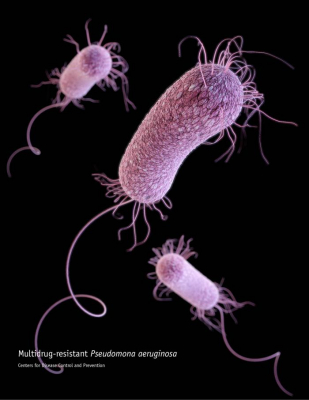 By G. Kago, Post Doctoral Fellow, Molecular Biosciences
By G. Kago, Post Doctoral Fellow, Molecular Biosciences
This month’s blog post features the work of scientists who are trying to understand one way in which the pathogenic bacterium Pseudomonas aeruginosa distinguishes between whether it will cause short infection or long, sustained infection. This work was conducted by a collaborative team that featured LCID Faculty member Dr. Chris Sullivan and Interdisciplinary Life Sciences Graduate Program (ILSGP) student Kayla Szymanik, along with their collaborators at Georgia Tech, Texas Tech, Emory University, Binghamton University, and the Mayo Clinic.
P. aeruginosa is an infectious bacterium that has the ability to cause short term or acute infections in some cases, and long term or chronic infections in others. It typically occurs in hospital settings where it causes infections in patients in the blood, lungs (becoming pneumonia), or other parts of the body.
A persistent gap in the field has been: how does this bacterium switch between acute and chronic infection statuses? More specifically, are there molecular mechanisms and environmental signals that help it to determine whether to (1) infect, replicate, and spread quickly, manifesting an acute infection, or to (2) develop slowly and persist over a long period of time manifesting a chronic infection?
This collaborative team began their study by comparing genes which were expressed in samples from infected humans and comparing them to cultures grown in the laboratory. Interestingly, one of the genes that they found was made over 200-fold times more in the samples from human patients. In an investigation to determine whether this gene made a protein that was important, they noted a particular molecular signature that told them it did not encode instructions to make a protein, but rather a small regulatory molecule called a small RNA.
To better understand how this small RNA could govern the switch between the two infection states, they exposed two strains of P. aeruginosa into living mouse models: the regular P. aeruginosa strain, or what scientists call “wild type”, and a strain without the small RNA. They observed that while both strains grew in the host, the strain without the small RNA gene showed increased spread and increased lethality which is not an outcome that occurs in this particular model under wild type P. aeruginosa infection.
Additionally, in a different type of experimental mouse model, the authors observed that mice infected with sublethal doses of these two P. aeruginosa strains had comparable amounts of bacteria in the lung, but in the spleen, the strains without the small RNA were enriched 100-fold. These two observations indicated that this small RNA must be important for helping the bacteria to conduct a localized infection. This distinction is relevant for the distinction between systemic infections, or infections that infect the whole-body vs localized infections, or infections that are specific to one body organ.
Further, when the scientists tested the induction of the small RNA in low oxygen environments which are commonly encountered in human chronic infection, they observed a 25-fold increase. Taken together, these findings add to the understanding of the specific molecular contributors that are involved in helping P. aeruginosa to adjust both to its environment and to different infection states.
To read the article, click here.

